MARKETING
45 Free Content Writing Tools to Love [for Writing, Editing & Content Creation]
![45 Free Content Writing Tools to Love [for Writing, Editing & Content Creation] 45 Free Content Writing Tools to Love [for Writing, Editing & Content Creation]](https://articles.entireweb.com/wp-content/uploads/2023/02/45-Free-Content-Writing-Tools-to-Love-for-Writing-Editing.jpgkeepProtocol.jpeg)
Creating content isn’t always a walk in the park. (In fact, it can sometimes feel more like trying to swim against the current.)
While other parts of business and marketing are becoming increasingly automated, content creation is still a very manual job.
That being said, there are plenty of tools out there to make creating content much easier.
Below, you’ll find a list of 36 fantastic tools and resources to help you research, write, edit, and design content more easily. (You’ll notice there are a lot of design tools in here — that’s because visual content is often the part of the content creation process where people get the most nervous and frustrated. So don’t worry, we’ve got a ton in there for you.)
Let’s get started.
36 Free Tools & Resources to Make Content Creation Easier
For Researchers
1) Google Drive Research Tool
Google recently added a tool to Drive that allows you to conduct Google searches without ever leaving your Drive window. All you have to do is click “Tools” from the menu bar and choose “Research” from the dropdown menu.
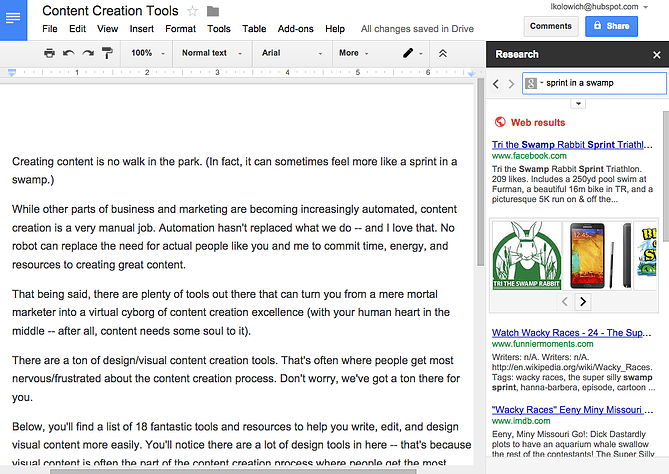
2) Site:search
This is a handy Google hack I use every day. Basically, it allows you to do a Google search that’s limited to a particular website.
For example, if I wanted to search HubSpot’s blog for marketing resources so I can cite one of our old blog posts, I’d do a site:search for blog.hubspot.com with the search term marketing resources. The formula for site search is site:samplewebsite.com [search query]. So my example would be site:blog.hubspot.com marketing resources.
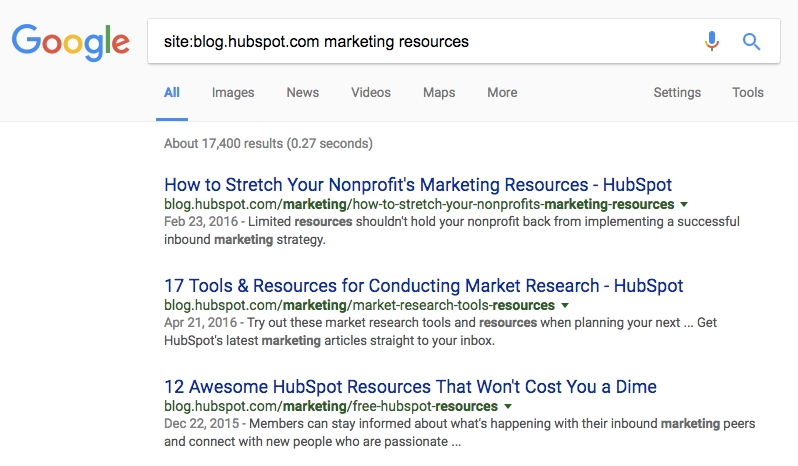
3) Google Webmaster Tools
Doing SEO and keyword research? Your marketing software should be able to help. But if it can’t (or you’d like to augment your data), Google’s Webmaster Tools can be a great help. You can check things like the number of indexed pages on your website, submit your site to Google so you’re getting crawled and indexed, and even disavow bad inbound links. It also can give you information on search queries that have a large volume of impressions but low clickthrough rate.
Within Google Webmaster Tools, go to “Your site on the web” and choose “Search queries.” You’ll see a table showing a search query, impressions, clicks, and clickthrough rate (CTR). Comparing this data to your other analytics data can help uncover some opportunities.
4) Percentage Change Calculator
I can’t even begin to tell you how useful this little calculator is when looking for and analyzing data. Ever want to know the percentage change of two values without having to remember the formula? Simply enter the two values into this calculator, and it’ll spit out the percentage change. Trust me, you’ll want to bookmark this one.
Here are a few other handy calculators:
- 3-Way Percentage Calculator – Calculates answers to these questions: What is X% of Y? X is what percent of Y? X is Y% of what?
- Conversion Rate Calculator – Spits out a conversion rate when you enter the total visitor count during a specific time frame and the number of times during that time frame those visitors took a specific action.
- A/B Test Calculator – Works for a basic scenario with two groups of people (A & B) who get to see one version of your website and for whom you track the number of conversions or goals (purchases, downloads, clickthroughs, etc.).
- ROI Calculator – Analyzes your website’s monthly sales and lead generation efforts to determine ways in which marketing efforts can be optimized.
5) Atlas
Atlas is Quartz‘s data center, and it’s chock-full of graphs, charts, and data visualizations. You can search for almost any topic or keyword, and Atlas will have a graphic based on recent research data for you. This is a great tool to get background information on a topic you’re researching, or to find fresh data to use in a project you’re working on. Here’s a chart based on data from early 2016:
![45 Free Content Writing Tools to Love [for Writing, Editing & Content Creation] atlas dogs.png](https://articles.entireweb.com/wp-content/uploads/2023/02/1675460504_700_45-Free-Content-Writing-Tools-to-Love-for-Writing-Editing.png) Source: Atlas
Source: Atlas
6) Search in a Giphy
You know that coworker who always seems to find the perfect animated GIFs for your social posts or internal chat client? With the free Giphy Chrome extension, you’ll be able to find great GIFs just as quickly.
To use the tool, all you have to do is open the extension in Chrome, search, choose a GIF, and drag and drop. So far, the tool works in Gmail, Twitter, Facebook, and more — and they’re constantly expanding support.
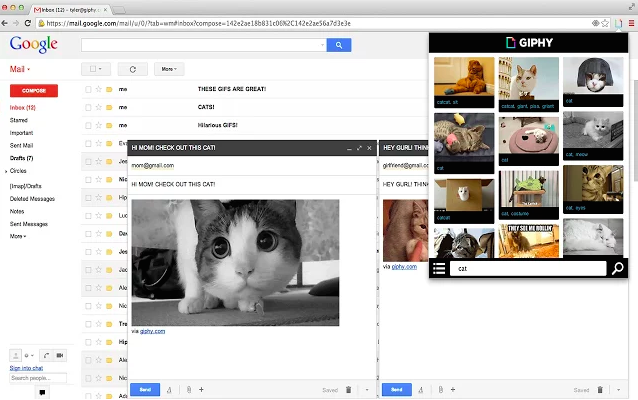
For Writers
7) Evernote
I use the free version of Evernote every single day. From to-do lists and research notes to writing entire chunks of articles, it’s proven helpful at every step of the writing and editing process.
One great feature? Its mobile, desktop, and web apps sync automatically as long as you have an internet connection. (And if you work offline, it’ll sync the next time you have internet.) Plus — and this is super important for content creators like us — it’s constantly saving and syncing your work automatically, making it a safe place to write and store ideas.
Use it to keep a running list of ideas, take notes, store inspiring articles or ebooks, or plan your editorial and social media publishing calendars.

8) Word2CleanHTML
If you like drafting blog posts in programs like Microsoft Word, Evernote, or Google Drive instead of your content management system (CMS), then this simple tool can be your best friend. Why? Because when you copy a document from Microsoft Office and paste it into your CMS, lots of little, weird formatting issues can crop up in your HTML.
Word2CleanHTML applies filters to fix all those things added into the HTML, resulting in well-formatted HTML you can paste directly into a web page CMS. Simply paste in your draft, click one button, and then copy the resulting HTML straight from the tool. When you paste that into your CMS (most will have buttons reading “HTML” or “</>” in their tool bar above your draft), it will appear nice and clean. No hair-pulling or swimming through code required.
9) WordCounter
There is no “right answer” for how long a blog post should be. As long as it serves its purpose — whether that’s thought leadership, driving leads, explaining a new concept, or something else — length doesn’t matter. But although we don’t recommend writing blog posts with a word count in mind, sometimes word count can come in handy. WordCounter works exactly the way you think it does: Paste in your content and it’ll spit out exactly how many words you have.
10) Cofftivity
According to a study out of the University of Chicago, “A moderate level of ambient noise is conducive to creative cognition.” In other words, being the tiniest bit distracted actually helps you be more creative. That’s why for many people, myself included, white noise helps promote focus.
There are a lot of white noise generators out there, but my favorite is Cofftivity. This particular one offers non-stop café background sounds at varying intensities, from “Morning Murmur” and “University Undertones” to “Lunchtime Lounge” and “Brazil Bistro.” It’s available on the web and as an app on iOS and Android.
11) & 12) Zerys & eLance
Need to start creating content but don’t have the bandwidth? We hear about this roadblock a lot. One way to get around it is by hiring freelancers from reputable marketplaces like Zerys or eLance. These resources give you access to skilled freelance writers who can write blog posts, ebooks, whitepapers, and other pieces of written content for you.
13) HTML Hacks for Marketers
While this isn’t strictly a writing resource, basic coding knowledge is quickly becoming a must-have skill for the modern marketer — bloggers and written content creators included. But learning from scratch can be daunting. Where on earth do you start?
If you’re a total beginner, start with HTML Hacks for Marketers, which my colleagues at HubSpot created with Codeacademy. It’ll teach you quick but useful hacks anyone — regardless of coding knowledge — can use in their marketing. For example, you’ll learn how to make small changes to HTML like altering headers and spacing, creating text in block-quote form, and inserting social share links. My personal favorite is the hack to change font colors.
Once you’ve mastered these basic HTML skills, move on to Codeacademy’s free interactive courses. They found a way to make learning HTML and CSS actually fun — and you can go through each lesson at your own pace.
14) Blog Topic Generator
If you need to get to writing blog posts but aren’t sure of an angle or title to get your creativity moving, HubSpot’s Blog Topic Generator can do the work for you. Simply enter a few keywords that your blog focuses on, and the Blog Topic Generator will produce a week’s worth of titles and topic ideas for you. It might not produce the final title of your blog post, but it helps get you thinking about creative new angles for topics you’ve written about before.
Here are the blog post titles I received when I entered “content,” “inbound marketing,” and “blogging”:
![45 Free Content Writing Tools to Love [for Writing, Editing & Content Creation] generator_contentcreation.png](https://articles.entireweb.com/wp-content/uploads/2023/02/1675460505_761_45-Free-Content-Writing-Tools-to-Love-for-Writing-Editing.png)
15) Blog Post Templates
All blog posts aren’t created equal, but we’ve found that there are steps you can take to make your posts comprehensive and shareable. With these blog post templates, we’ll walk you through an outline to write successful how-to, listicle, newsjack, and curation blog posts. Instead of starting from scratch, you’ll save time and, hopefully, nail your blog goals.
For Content Editors
16) Editorial Calendar Template
Creating a balanced editorial calendar can be tough, especially if you don’t have one centralized calendar that you and your team can refer to. To save you time and headache, we’ve created editorial calendar templates for Google Calendar, Google Sheets, and Excel that you can fill in and share with your team to start the next month or year off on the right foot.
17) & 18) Grammarly & Correctica
While human editors will be able to catch most grammatical errors, editing tools like Grammarly and Correctica are great tools for triple-checking before you press “publish” or “send.” Both free tools check for grammatical errors — and Grammarly even checks for plagiarism.
19) Hemingway App
Ernest Hemingway, admired for his succinct writing style, is the namesake for this handy editing app. Want to make your written content easier to read? Paste your content into this free web app, and it’ll assess your writing and identify opportunities to make it simpler.
My favorite features include identifying passive voice and hard-to-read sentences. Check out the right-hand side of the screenshot below, where the tool has summed up how readable my writing is with a grade. (Some room for improvement here.) Their suggestion to improve readability overall? Shoot for lower than a 10th grade reading level.
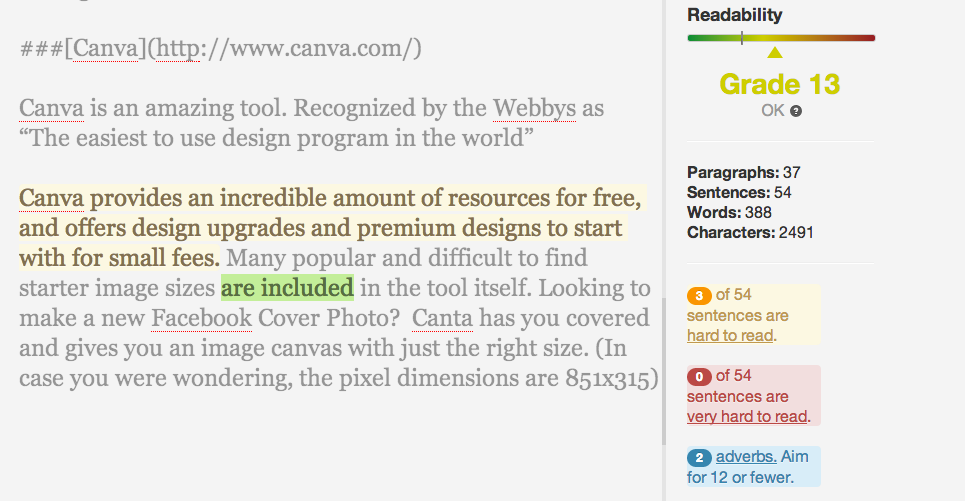
20) Headline Analyzer
Here’s a scary stat for you: Only 60% of people who click into an article end up reading past the headline. That makes your headline both the first and possibly the only chance for you to compel readers to keep reading — so it’s totally worth it to spend the extra few minutes coming up with a really good one.
What does a really good headline look like? The free tool Headline Analyzer by CoSchedule can tell you. It scores your headline quality and rates its ability to drive social shares, traffic, and SEO value. In my experience, its strength is helping you strengthen specific components of your title. For example, it reports on perceived sentiment and commonality of word types. It’ll even show you how it will appear in search results.
So although you should take these scores and grades with a grain of salt, you can use this to give your headlines a “once-over.” (And read this blog post to learn more about writing awesome headlines.)
For Designers
21) Nimbus Screenshot
This is another tool I use every day. Sure, you can capture a screenshot of your entire screen or part of your screen using the old keyboard shortcut method. But what if you want your screenshot to include stuff that’s not visible on your screen?
Nimbus Screenshot lets you capture the visible part of a web page, a selected area, a selected scroll (my personal favorite), the entire page, or the entire browser window — including everything below the fold.

Once you’ve taken the screenshot, you can crop, edit (like adding notes and callouts), and choose to print or save to your desktop or Google Drive.
22) Canva
If you like creating beautiful visual content in a really short amount of time, you’ll love Canva. The time and resources it takes to learn design, pay for design assets, and/or get inspired to create beauty from scratch can be really difficult when you’re staring at a long list of to-dos — but Canva offers a huge library of pre-made templates and assets that you can manipulate while also adding your own imagery.
Best of all, they have so many assets and graphics available for free that you won’t have to pay a cent if you don’t want to. If you want to use more “premium” assets and graphics found through their image search, they’ll charge you $1 for each. But there’s plenty of value for free.
Here’s an example of something you could make:
![45 Free Content Writing Tools to Love [for Writing, Editing & Content Creation] hubspot_canva_example](https://articles.entireweb.com/wp-content/uploads/2023/02/1675460505_239_45-Free-Content-Writing-Tools-to-Love-for-Writing-Editing.png)
23) ThingLink
Ever wanted to make an image (or infographic) clickable? ThingLink lets you upload an image and add little icons to it that appear when a person hovers their cursor over the image. These icons allow users to visit links, watch videos, or read messages you’ve written. Plus, it’s easy to share: Users can easily embed ThingLink images. (Click here for step-by-step instructions.)
Below is part of a a clickable infographic from Thinglink my colleague Ginny Mineo created for another post:
![45 Free Content Writing Tools to Love [for Writing, Editing & Content Creation] 45 Free Content Writing Tools to Love for Writing Editing](https://articles.entireweb.com/wp-content/uploads/2023/02/45-Free-Content-Writing-Tools-to-Love-for-Writing-Editing.jpeg;charset=ISO-8859-1')
24) Skitch
Skitch is a free app by Evernote that helps you communicate more visually. It lets you mark up images, digital assets, PDFs, and other files with arrows, callout boxes, text, and more all in one place.
In the example below, I opened the program on my desktop and used the “Screen Snap” button to take a screenshot of a web page — which then opened right in Skitch for editing and exporting.

Although it’s free, it does require you to open an Evernote account — but that’s also free (see above).
25) Infogram
While similar to Canva, Infogram is a visual content tool that focuses on helping you create infographics, charts, and data visualization. If you like to create charts using Microsoft Excel, you’re in luck — it also offers compatibility with Excel through Infogram Charts. Also, their infographics are responsive with mobile devices.
26) Infographic Templates
As a content marketer, you might feel more comfortable creating written content than visual content, but that’s no excuse to exclude infographics from your strategy. Visual content is growing in demand from your audience, and infographics are particularly shareable. We’ve created the backbones of 15 different templates that you can easily play around with to customize for your content and audience — here’s a sneak peek of one template, and you can grab the rest here.
![45 Free Content Writing Tools to Love [for Writing, Editing & Content Creation] IGtemplate_datageek.png](https://articles.entireweb.com/wp-content/uploads/2023/02/1675460505_276_45-Free-Content-Writing-Tools-to-Love-for-Writing-Editing.png)
Source: 15 Free Infographic Templates in PowerPoint
27) Google Fonts
Want to spruce up your site pages, presentations, ebooks, and other content with cool and different new fonts? Little-known fact: Google has a directory of 600 free fonts ready for you to download and use.
Simply find and select the fonts you like from their directory, then click “Use” to get the HTML code you can copy and paste onto your site. Alternatively, you can download the fonts to your desktop and use them when making new marketing content by clicking “Add to Collection.” (Click here for step-by-step instructions for doing this in the HubSpot software.)

28) Image Color Picker
Remember that time you wanted to match your call-to-action design to that color you were using on all your event swag … but the one person who would know what that color was didn’t work at your company anymore? Next time that happens, snag a picture of that swag and upload it to ImageColorPicker.com, or use any image URL to do the same thing. Select any point of the picture, and immediately see its corresponding HEX, RGB, and HSV values.
29) PowerPoint Templates
Is there anything more boring than a PowerPoint presentation featuring black text on a white background? With the help of these templates, you’ll be able to put together compelling, visually appealing presentations. Whether you’re driving lead generation or reporting on your blog’s growth to your team, keep your audience’s attention with these eye-catching presentations.
30) SlideShare Templates
SlideShare doesn’t need to be daunting. You can easily create shareable, embeddable SlideShare presentations in PowerPoint with the help of these templates — no need to start from scratch or hire a freelancer. Once you’ve created your first presentation, check out our guide to marketing SlideShares successfully.
31) Haiku Deck
If you’ve ever had to create a PowerPoint or SlideShare presentation in a pinch, you’ll wish you knew about Haiku Deck. This tool helps you quickly find simple layouts, beautiful images, and great fonts. It’s available for the web and for iPad.
Want to see what one looks like? Below’s an example I pulled from their list of featured decks. Note the simplicity of the design — if you want to create super detailed slides, this may not be the right tool for you.
Snowed In? – Created with Haiku Deck, presentation software that inspires
32) HubSpot’s Free Stock Photos
Searching for and buying stock imagery can be a pain in the you-know-what — especially when it comes to deciphering legalese for different use cases. I have a liberal arts degree, and Nietzsche was easier to read than whatever legalese stock imagery companies tended to give me. All I wanted to know is whether to cite or not cite a stock image of a laptop. Why was it so hard?
That’s why our team decided to create a library of 550+ free and royalty-free stock photos. Whether it’s a unique image needed for an ebook or that perfect photo you want to add to a blog post, that collection should have you covered. Here’s one of our “around the kitchen” stock photos — yum.
![45 Free Content Writing Tools to Love [for Writing, Editing & Content Creation] candy-3.jpg](https://articles.entireweb.com/wp-content/uploads/2023/02/1675460506_838_45-Free-Content-Writing-Tools-to-Love-for-Writing-Editing.jpg)
Source: The Free Stock Photos You’ve Been Searching For
33) PlaceIt
PlaceIt serves a very specific purpose: It allows you to upload images of your site or product into real-world environments of people holding phones, tablets, and laptops. PlaceIt will automatically alter the image to make it appear natural with the angle of the phone’s screen — which will save you time learning and/or editing in more advanced software to get the angle right.
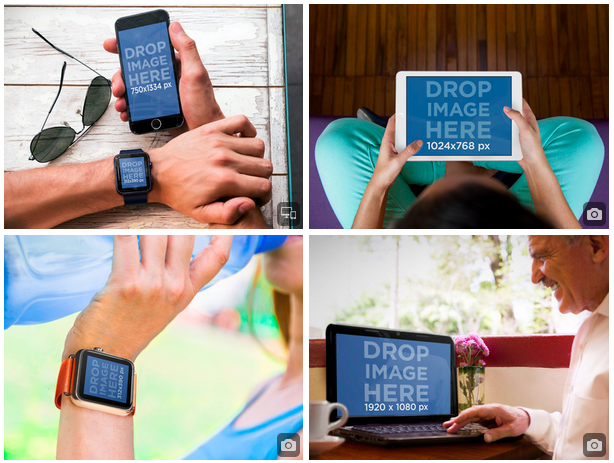
You’ll have to pay per image to get really large or high-resolution versions, though I’ve found free images work just fine for blog posts and product page content. The paid downloads also remove that PlaceIt watermark from the bottom right.
34) LICEcap
Looking for the perfect GIF to include in your blog post? If it doesn’t already exist on Giphy, you can make one yourself using LICEcap. Film a screenshot and turn it into a GIF using this handy, free tool — we use LICEcap for our blog posts, too.
35) & 36) The Noun Project & HubSpot’s Resizable Icons Collection
Like with stock photos, another challenge content creators face is finding elegant icons that resize without getting all fuzzy. There are a few resources out there for great, resizable icons.
The Noun Project is an extensive library of thousands of icons uploaded by contributors. With a free account, you can use icons as long as you either give credit to the creator or purchase them royalty-free for $1.99 apiece.
HubSpot has a library of resizeable icons, too, which you can download for free and without any licensing or attribution. The kit comes with a free guide for how to change the color of the icons using PowerPoint, Photoshop, and Illustrator.
To that, we say …
![45 Free Content Writing Tools to Love [for Writing, Editing & Content Creation] general-icons-26](https://articles.entireweb.com/wp-content/uploads/2023/02/1675460506_784_45-Free-Content-Writing-Tools-to-Love-for-Writing-Editing.png)
(From HubSpot’s Free Icon Collection.)
It’s Not the Wand, It’s the Wizard
The tools and resources listed above can help you create, but it’s ultimately up to you to control the quality of your content. You still need to know your customer incredibly well, understand what challenges they face that your product or service solves, and create content that helps them address those challenges.
The brains and heart behind the content creator trump the code behind any tools and technology — and that’s a good thing for succeeding in marketing today.
What other tools or apps do you use to create content more easily? Leave them in the comments so we can extend this list right here!
Editor’s Note: This post was originally published in December 2013 and has been updated for accuracy and comprehensiveness.
MARKETING
The key to correcting the C-suite trust deficit

Take a moment to search “CMO tenure” and you’ll find a wide variety of content discussing the short tenure of CMOs and how it’s among the shortest of roles in the C-suite. If you dive deeper, you’ll find that CEOs don’t seem to trust CMOs.
Boathouse’s CMO Insights study (registration required) noted several sobering conclusions:
- 34% of CEOs have great confidence in their CMOs.
- 32% of CEOs trust their CMOs.
- 56% of CEOs believe their CMO supports their long-term vision.
- And only 10% of CEOs believe their CMO puts the CEO’s needs before their own.
If these statistics also apply to the CMO’s entire organization, then it’s clear we have a trust problem with marketing leadership.
If you haven’t read Patrick Lencioni’s “The Five Dysfunctions of a Team,” I consider it required reading for anyone in any leadership role. In his book, Lencioni builds a pyramid of dysfunctions that need to be addressed for a team to succeed. The foundational dysfunction — with which one cannot build a successful team — is “absence of trust.” We see it at scale with marketing organizations today.
Introducing objectivity through data
In “Hamlet,” Shakespeare writes, “There is nothing either good or bad, but thinking makes it so.” Each organization that makes up a company looks at the company from a different perspective. What marketing sees as positive, finance may see as negative. But who’s right? No one.
Usually, there is no objectivity because leadership comes up with an idea and we execute it. It’s like the fashion proverb “Beauty is in the eye of the beholder.” Unfortunately, we’re going to struggle to run a profitable organization if it’s run like a fashion show.
Therefore, we need to introduce objectivity to how we work. Leadership needs to come together to agree on goals that align with the goals of the broader organization. One element of this conversation should be an acknowledgment that this is turning a ship.
Often leaders — especially those without marketing backgrounds — are likely to expect instant gratification. It’s going to take time to turn the ship and you and your team would do well to set reasonable expectations right away.
Dig deeper: KPIs that connect: 5 metrics for marketing, sales and product alignment
Aligning goals and metrics across the organization
With goals in hand, we need to assign metrics to their progress and agree on the source(s) of truth. Once these objective measures are in place, perspective doesn’t matter. 2 + 2 = 4 regardless of whether you’re in HR or accounting.
Every public road has a speed limit and whether you’re in compliance with it has nothing to do with your perspective. If you’re above it, you’re wrong and subject to penalties. Referring to the fashion example, it’s not a fashion show where some people like a dress and others don’t.
By using data to objectively measure marketing’s progress within the organization and having the rest of the leadership buy into the strategy, we build trust through objectivity. Maybe the CEO would not have chosen the campaign the marketing team chose.
But if it was agreed that a >1 ROAS is how we measure a successful campaign, it can’t be argued that the campaign was unsuccessful if the ROAS was >1. In this example, the campaign was an objective success even if the CEO’s subjective opinion was negative.
Data-driven campaign planning
Within the marketing organization, campaigns should always be developed with measurement top of mind. Through analysis, we can determine what channels, creative, audiences and tactics will be most successful for a given campaign.
Being able to tell the leadership team that campaigns are chosen based on their ability to deliver measured results across metrics aligned to cross-departmental goals is a powerful message. It further builds trust and confidence that marketing isn’t run based on the CMO’s subjective opinions or gut decisions. Rather, it’s a collaborative, data-driven process.
For this to be successful, though, it can’t just be for show, where we make a gut decision and direct an analyst to go find data to back up our approach. This would be analytics theater, which is a perversion of the data. Instead, tell the analyst what you think you want to do and ask them to assess it.
For the rest of the organization’s leadership, ask questions when the marketing team presents a campaign. Find out how they came up with the strategy and expect to hear a lot about data — especially the metrics you all agreed would support the company’s overarching goals.
Dig deeper: 5 failure points of a marketing measurement plan — and how to fix them
Data literacy: Building credibility through transparency
Building trust doesn’t happen overnight, but a sustained practice of using data to drive marketing leadership’s decisions will build trust if the metrics ladder up to the organizational goals and all of leadership is bought into the measurement plan.
Over time, this trust will translate into longer tenure and more successful teams through building the infrastructure needed to tackle Lencioni’s five dysfunctions.
Opinions expressed in this article are those of the guest author and not necessarily MarTech. Staff authors are listed here.
MARKETING
How Tagging Strategies Transform Marketing Campaigns


As a marketer, I understand how today’s marketing campaigns face fierce competition. With so much content and ads competing for eyeballs, creating campaigns that stand out is no easy task.
That’s where strategies like tagging come in.
It helps you categorize and optimize your marketing efforts. It also helps your campaigns cut through the noise and reach the right audience.
To help you out, I’ve compiled nine ways brands use a tagging strategy to create an impactful marketing campaign.
Let’s get to it.
How Brands Use a Tagging Strategy
Tagging involves using keywords or labels to categorize and organize content, products, or customer data. You attach tags to specific items or information to make searching, sorting, and analyzing data easier.
There are various types of tags, including meta tags, analytics tags, image tags, hashtags, blog tags, and more.
So, how do brands use a tagging strategy to make their marketing campaigns stand out?
Improve Social Media Engagement
With over 5 billion users, social media provides an easy way to connect with your audience, build relationships, and promote your offerings.


Use a tagging strategy to boost social media interactions. Consistently use hashtags that align with current trends and topics. This encourages people to interact with your content and boosts content visibility.
You can also use tags to monitor brand mentions of your products or your industry. This allows you to engage with your audience promptly.
Consider virtual social media assistants to streamline your tagging strategy. These AI-driven tools can suggest relevant hashtags, track mentions, and automate responses. Implementing them can save time and resources while ensuring consistent engagement across your socials.
Build a Personal Brand on LinkedIn
LinkedIn is the world’s largest professional networking platform, with over 1 billion members across 200 nations. It offers excellent opportunities for individuals and businesses to build and nurture their brands.


However, simply creating a professional profile isn’t enough to build a personal brand on LinkedIn.
Use various tags to increase your visibility, establish thought leadership, showcase expertise, and attract the right connections. For instance, use skill tags to showcase your expertise and industry tags to attract connections and opportunities within your industry. Use certification tags to help showcase your expertise and credibility to potential employers or clients.
Facilitate Customer Segmentation and Personalization
Personalization matters—more so in today’s data-driven world. In fact, 65% of consumers expect your brand to adapt to their changing preferences and needs.
To meet this expectation, consider using a tagging strategy.
Segment your customers based on shared characteristics, such as demographics, interests, purchase history, cart abandonment, and behavior.
Here’s a summary of the steps to customer segmentation.


With your customer segments ready, use tags to tailor your marketing messages and offerings to specific segments. Imagine sending targeted email campaigns based on what your customers need. That’s the power of segmentation and tagging in action!
Enhance SEO and Content Discoverability
Tagging content can have a profound impact on search engine optimization (SEO) and content discoverability. When users search for specific topics or products, well-tagged content is more likely to appear in search results, driving organic traffic to your website.
Additionally, tags can help you analyze the most popular topics with your readers. Then, the results of this analysis can help you adjust your content strategies accordingly.
And get this— certain AI tools can help analyze your content and suggest relevant tags and keywords. Using these tools in addition to a tagging strategy can help optimize your SEO strategies and boost content discoverability.
Partner with the Right Influencers
Influencer marketing has become a go-to marketing approach for modern brands. Recent stats show that 85% of marketers and business owners believe influencer marketing is an effective marketing strategy.
But how do you find the perfect influencer for your campaign?
Utilize tags to identify influencers who are relevant to your niche. Beyond this, find influencers who align with your brand values and target audience.
Additionally, look for influencers who use hashtags that are relevant to your campaigns. For instance, fashion influencer Chiara Ferragni uses #adv (advertising) and #ghd (good hair day) hashtags in this campaign.


Monitor industry-specific hashtags and mentions to discover influential voices and build profitable relationships with them.
Track Hashtag Performance
Tracking your hashtag performance helps you understand your campaigns’ engagement, reach, and effectiveness.
To achieve this goal, assign special hashtags to each marketing project. This helps you see which hashtags generate the most engagement and reach, enabling you to refine your tagging strategy.
Here’s an example of a hashtag performance report for the #SuperBowl2024.


This curated list of hashtag generators by Attrock discusses the top tools for your consideration. You can analyze each and choose the one that best fits your needs.
Categorize Content Accordingly
The human attention span is shrinking. The last thing you want is for your audience to have difficulty in finding or navigating your content, get frustrated, and bounce.


Untagged content can be difficult to navigate and manage. As any marketer knows, content is important in digital marketing campaigns.
To categorize your content, identify the main categories by topics, themes, campaigns, target audiences, or product lines. Then, assign relevant tags based on the categories you’ve identified. After that, implement a consistent tagging strategy for existing and new content.
Organizing your content using tags can also help streamline your content management workflow. Most importantly, readers can easily find the content they’re looking for, thereby boosting overall user experience, engagement, and conversions.
Boost Your Email Marketing Strategy
Email marketing remains a powerful marketing tool in today’s digital world. It’s also another area where brands use a tagging strategy to directly reach their target audience.
Use tags to segment your email list and personalize your marketing messages. Then, you can send targeted emails based on factors like purchase history, interests, and demographics.
Personalization can significantly improve open rates, CTRs, and overall engagement and conversion rates. It’s a simple yet impactful strategy to make your email marketing strategy more effective.
Plus, you can use tags to track how well your emails perform with each group. This helps you understand what content resonates best with your audience and provides insight on how to improve your emails going forward.
Enhance Analytics and Reporting
Every marketer appreciates the immense value of data. For brands using tagging strategies, tags are powerful tools for gathering valuable data.
Analyze how users interact with your tagged content. See which tags generate the most clicks, shares, conversions, and other forms of engagement. Gain insight into audience preferences and campaign effectiveness.
This granular data about your marketing efforts allow you to make data-driven decisions, allocate resources effectively, and refine your marketing strategies.
Final Thoughts
There isn’t a single correct way for brands to use a tagging strategy in marketing. You can use a tagging strategy however you see fit. However, the bottom line is that this strategy offers you a simple yet powerful way to create attention-grabbing and unique marketing campaigns.
Fortunately, tagging strategies are useful across various marketing initiatives, from social media and email marketing to SEO and more.
So, if you’re ready to elevate your marketing campaign, build a strong brand presence, and stand out among the competition, consider employing effective tagging strategies today.
MARKETING
Tinuiti Recognized in Forrester Report for Media Management Excellence

Tinuiti, the largest independent full-funnel performance marketing agency, has been included in a recent Forrester Research report titled, “The Media Management Services Landscape, Q2 2024.” In an overview of 37 notable providers, this comprehensive report focuses on the value B2C marketing leaders can expect from a media management service provider, and analyzes key factors to consider when looking for a media management partner such as size and business scenarios. B2C marketing executives rely on media management services to:
- Augment the efficacy of media investments
- Bridge media impressions to commerce transactions
- Enhance ad campaigns to drive performance
Report authors, VP, Principal Analyst Jay Pattisall and Senior Analyst Nikhil Lai call attention to the pressing need for providers to prove their value, deliver profitable ROAS, and drive alignment between CMOs and CFOs and thus liberate strained marketing budgets.
Our Always-On Incrementality tool – which is a part of our patented tech, Bliss Point by Tinuiti – empowers marketers to validate the incrementality of their spend on each ad set, media channel, and marketing tactic so marketers can create stronger, more focused campaigns that get the job done without sacrificing the bottomline.
B2C marketing leaders often seek and expect key business scenarios from media management service providers including media measurement and attribution, data strategy, and marketing mix modeling. MMM’s adaptability to the post-cookie/ post-IDFA world positions it as an essential tool for marketers. As businesses seek to connect the dots, leverage data, and make strategic decisions, MMM is a crucial ally in the dynamic realm of mixed media advertising. Our Rapid Media Mix Modeling sets a new standard in the market with its exceptional speed, precision, and transparency.
According to the Forrester report, “46% of senior B2C marketing and advertising decision-makers say they plan to integrate performance and brand media assignments with a single media agency in the next 12 months…”
In our quest to better understand all revenue-driving aspects of a given campaign, we have started on a process to quantify the impact of Brand Equity, which we believe is one of the largest missing pieces in more accurate and complete measurement.
Learn more about Bliss Point by Tinuiti, our use cases, and our approach to performance and brand equity.
The Landscape report is available online to Forrester customers or for purchase here.
-
SEARCHENGINES7 days ago
Daily Search Forum Recap: April 29, 2024
-
SEARCHENGINES6 days ago
Daily Search Forum Recap: April 30, 2024
-

 MARKETING5 days ago
MARKETING5 days agoHow To Develop a Great Creative Brief and Get On-Target Content
-

 SEO7 days ago
SEO7 days agoGoogle’s John Mueller On Website Recovery After Core Updates
-

 SEO5 days ago
SEO5 days agoWhy Big Companies Make Bad Content
-

 WORDPRESS5 days ago
WORDPRESS5 days ago13 Best Fun WordPress Plugins You’re Missing Out On
-

 SEO6 days ago
SEO6 days agoOpenAI To Show Content & Links In Response To Queries
-

 SEO5 days ago
SEO5 days agoHow To Drive Pipeline With A Silo-Free Strategy


![45 Free Content Writing Tools to Love [for Writing, Editing & Content Creation] Download 195+ visual marketing design templates to use for social media posts, infographics, and more.](https://articles.entireweb.com/wp-content/uploads/2023/02/45-Free-Content-Writing-Tools-to-Love-for-Writing-Editing.png)
![45 Free Content Writing Tools to Love [for Writing, Editing & Content Creation] download 195+ free design templates](https://articles.entireweb.com/wp-content/uploads/2023/02/1675460506_141_45-Free-Content-Writing-Tools-to-Love-for-Writing-Editing.png)















You must be logged in to post a comment Login